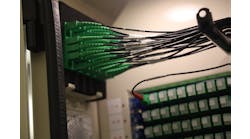In a $36 million deal that showcases how to run microgrids on clean baseload energy, Stratean, a developer of a clean gasification system, has acquired CleanSpark, a provider of engineering, software and controls for distributed energy systems.
The two companies say the deal will solve a critical challenge facing microgrid developers today: the need to use clean energy sources as baseload power.
“The merger makes perfect sense,” said Matthew Schultz, CEO of Stratean in an interview. “In many microgrids, baseline power is still from the grid or diesel power. We can replace that with fully renewable solutions that are autonomous from the existing power structure.”
Stratean plans to integrate technologies from the two companies into a unified solution, he said.
The Utah-based company uses a patented “downdraft” gasification process to produce clean syngas fuels from biomass. The syngas is 100 percent pollution-free, and offers a low-cost way to produce electricity, according to the company.
“In most gasification models, the amount of energy consumed during the creation of energy is 30 to 50 percent of the power generated,” Schultz explained. “Our reaction is self-sustained within the reactor; it provides its own heat source. It can go completely off grid and stay off the grid.”
Microgrids on clean baseload
“The heart of the systems is the (Stratean) reactor, which has the ability to provide power and energy,” said Michael Firenze, CEO of CleanSpark. “The microgrid–storage and renewable energy–operates on the external level, providing the power needed and our software is constantly managing loads and connecting and isolating from the grid.”
Generally, if microgrid developers want to go for “the holy grail of 100 percent renewables,” they must oversize the renewable energy and storage systems–sometimes by 250 percent to meet peak loads, Firenze said.
“This helps solve the baseload generation problem and optimizes the system so we don’t have to oversize the renewables and energy storage. We can now use the baseload generation from Stratean’s gasification technology and properly size the renewable and energy storage components,” said Firenze.
The all-equity deal transfers to Stratean ownership of CleanSpark’s subsidiaries, patent-pending fractal grid software technology, contracts, patents, and other software and related assets.
CleanSpark provides software and controls that integrate generation and storage with advanced load management capacities. The software allows energy generated locally to be shared with other interconnected microgrids. The microgrids can then be scaled and widely adopted.
CleanSpark has in place solar microgrid projects totaling about 2 MW, said Firenze. They include a microgird at the School of Infrantry in the 52 Area of Marine Corps Base Camp Pendleton and some commercial projects in California.
The company won the contract to provide design, development, integration and installation services for the FractalGrid at Camp Pendleton in 2013. The project uses CleanSpark’s mPulse software and controls platform with energy storage to store solar energy generated by existing fixed-tilt solar photovoltaic panels and 15 dual-axis tracking concentrated photovoltaic units.
CleanSpark’s controls create four separate microgrids that work together, creating a larger microgrid that ties into the larger utility grid. The base unit can then consume energy from the most reliable, affordable source at any given time. CleanSpark software can autonomously separate the microgrids from the utility and operate them in island mode, then reconnect to the utility.
“We are on the forefront of the microgrid industry because we have been working for a long time with the military, and have had to bulldoze our way through a lot of problems,” said Firenze. For example, storage was a challenge 10 years ago, but is now widely available, he said.
“Now the software and controls market is catching on in the industry,” Firenze said. “The next step: people will realize baseload generation is the issue. By providing examples, we will open the eyes of our partners and competitors so they can start solving this problem, as well. If our goal is to provide renewable energy around the world, this merger will help accelerate everyone’s knowledge and speed up the industry and the solution sets.”
Join the microgrid discussion on our LinkedIn Group, Microgrid Knowledge.







